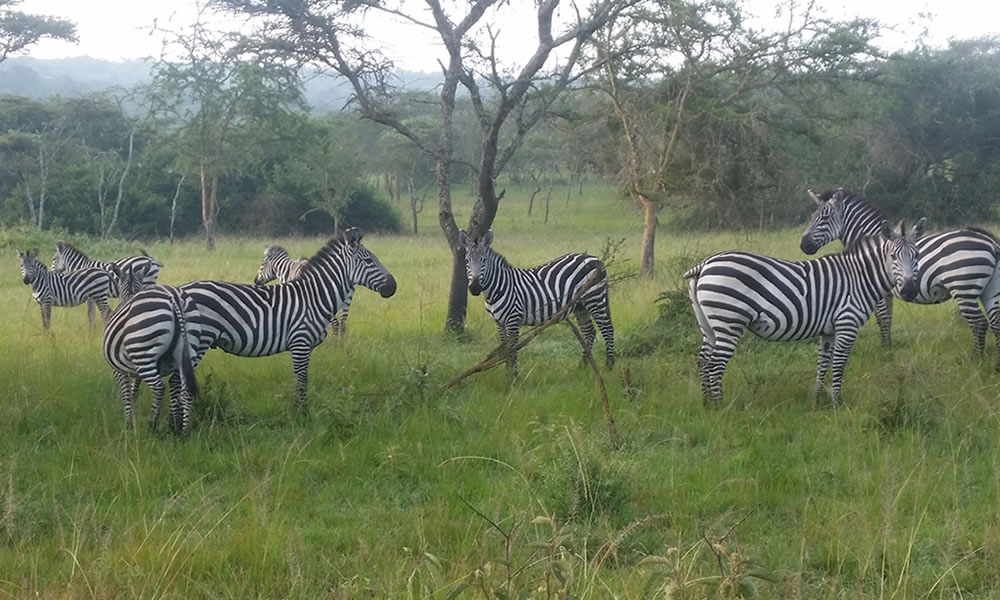The location of Lake Mburo National Park is in Kiruhura district, which is adjacent to Mbarara district, in western Uganda. It is Uganda’s smallest Savannah park, occupying an area of 260 square kilometres. Although there are eleven additional lakes nearby, Lake Mburo serves as the park’s hub for activities. A myth and tradition from the Ankole community states that Kigarama and Mburo, two brothers, previously inhabited a large valley that encircles the park. In a dream, Kigarama had insight concerning a threat to their safety if they persisted in remaining in the valley. Mburo didn’t think he was serious when he told her about his dream. Kigarama left the valley and went to safety up on the hills. Mburo was drowned when the valley was inundated with water one day. The hills adjacent were named Kigarama, and the Lake Mburo.

With an average annual rainfall of 798 mm, Lake Mburo National Park is situated in the rain shadow of the Rwenzori Mountains and Lake Victoria. It is ideally situated next to a highway that connects Uganda’s capital city, Kampala, to other popular tourist destinations in the west, including Queen Elizabeth National Park and Lake Bunyonyi. Travellers wishing to make stops during the lengthy trips to visit gorillas in Bwindi or chimpanzees in Kibale Forest Park are drawn to it because of its advantageous position. It’s the most easily accessible game park for anyone hoping to view Ugandan wildlife because of its close proximity to Kampala.
Due to poaching and invasion by nearby tribes, the wildlife of Lake Mburo National Park was almost completely eradicated throughout its violent history. In 1933, the park was established as a regulated hunting area, and in 1963, it became a game reserve.
These days, Uganda’s Lake Mburo National Park serves as an example of how local populations and wildlife may coexist. In addition to lions, giraffes, elands, baboons, and other species have been successfully reintroduced thanks to the cooperation between the government and the local population.
Things to do in Lake Mburo National Park
Bird Watching
One of Uganda’s greatest locations for birdwatching is Lake Mburo. The principal birding areas in Lake Mburo are the marshes of Warukiri and Miriti. Black-billed barbet, blue-napped mousebird, brown parrot, common quails, crested francolin, emerald spotted wood Dove, greenwood hoopoe, Lilac-breasted Roller, Nubian woodpecker, Rednecked Spur, trilling cisticola, white-winged warbler, and the Shoebill stork are a few of the species. Birders may also see the Rufous African-wattled plover, Black-bellied Bustard, Coqui francolin, Flappet larks, red-necked spur fowl, Rufuos chested Swallow, southern Red Bishop, temminck’s courser, and yellow-throated long claw while at the Rwonyo camp. African finfoot and the endangered white-backed heron can both be seen in Lake Mburo.
Game Drives
Several of the wildlife species seen at Lake Mburo are rare in the other parks in Uganda. Among the species are eland, Klipspringer, Impala, five thousand zebra, and enormous bush rats. The Lake Mburo National Park in Uganda is where leopards are most regularly spotted due to their high population per square kilometre.
Guided Nature Walks
In contrast to other Ugandan parks, nature walks are permitted anywhere within the park as long as they are organised and supervised by an armed Uganda Wildlife Authority guard. You can witness a variety of antelopes, zebras, buffaloes, and giraffes grazing while on the nature walk. Be mindful of the birds and butterflies as well. You may even see hippos making their way to the lake after feeding on land during the morning walks, or hyenas returning to their burrows following the night’s hunt.
The Lakeside Track
The natural trail is linked to the walk along the well-traveled Lakeside Track in the southern part of Lake Mburo. While strolling through this gorgeous forest, visitors can see bush duiker. The trail climbs to Kigarama’s summit, offering breath-taking views of Lake Mburo and the adjacent national park.
Fishing
Fishing species including tilapia, haplochromes, lungfish, and mud fish can be found in the many lakes and locations like Mazinga. There are no hippos or crocodiles in the secure area of Lake Mburo where the Mazinga fishing site is situated. Sport fishermen can arrange for assistance to fry their catch once they return to their lodge. To ensure leisure in between fishing sessions, there are shade structures next to the fishing pegs. Prior to their safari, travellers can obtain fishing licences and set up fishing equipment.
Day and Night Game Drives
During game drives in Lake Mburo National Park, you can see the majority of the park’s animals and birds. An armed ranger from the Uganda Wild Life Authority (UWA) leads the game drives and assists in identifying the various animal and bird species. During the night safari or in the early hours of the morning, leopards are frequently spotted at the “leopard rock.” Although they are present in the park, hyenas are not as common as they are in some of Uganda’s other large wildlife parks. During the two-hour night wildlife drives, one can easily identify genet, leopards, bush pigs, mongooses, and white-tailed mongooses.
Boat Cruise
Taking a boat trip around Lake Mburo can let you fully appreciate the magnificence of the Park. During the dry season, when most animals arrive to drink, this is especially true. While on the boat ride, guests can witness otters, buffaloes, zebras, antelopes, crocodiles, and hippos. Among the birds that are most frequently spotted during the boat ride are African Fish Eagles, Blue-headed Weavers, Cormorants, Green-necked Doves, Hammerkops, Herons, Malachite Kingfishers, Pelicans, Pied Kingfishers, Rufous Long-tailed Starlings, and Shoebill Storks. There is no defined duration for the boat cruise.
Horseback Riding
One of the two parks in Uganda where people can go out and see game from a horseback is Lake Mburo. Horseback riding safaris are also available in Uganda in the Kabwoya wildlife reserve, which is situated along Lake Albert. Safaris on horseback let guests get up close and personal with the wildlife. The bashful Eland and the zebras seem to know the horses. They do not flee as they would in the sight of safari automobiles, even though they nevertheless maintain their distance.
